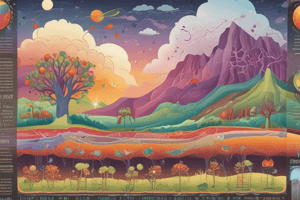Podcast
Questions and Answers
What is the primary product of glycolysis?
What is the primary product of glycolysis?
- Two molecules of pyruvate (correct)
- Four molecules of ATP
- Glucose 6-phosphate
- Two molecules of NAD+
Which enzyme catalyzes the phosphorylation of glucose in the first step of glycolysis?
Which enzyme catalyzes the phosphorylation of glucose in the first step of glycolysis?
- Hexokinase (correct)
- Amylase
- Phosphatase
- ATPase
During the energy-investment phase of glycolysis, how many ATP molecules are consumed?
During the energy-investment phase of glycolysis, how many ATP molecules are consumed?
- Two (correct)
- One
- Three
- Four
What is the role of NAD+ in glycolysis?
What is the role of NAD+ in glycolysis?
What is a key characteristic of the hexokinase-catalyzed reaction in glycolysis?
What is a key characteristic of the hexokinase-catalyzed reaction in glycolysis?
What occurs after glucose is phosphorylated by hexokinase during glycolysis?
What occurs after glucose is phosphorylated by hexokinase during glycolysis?
Which metabolic pathway occurs entirely in the cytosol of cells?
Which metabolic pathway occurs entirely in the cytosol of cells?
What is produced as a byproduct of glucose oxidation during glycolysis?
What is produced as a byproduct of glucose oxidation during glycolysis?
What is the primary purpose of the energy-payoff phase in glycolysis?
What is the primary purpose of the energy-payoff phase in glycolysis?
Which enzyme is responsible for the oxidation of glyceraldehyde 3-phosphate in glycolysis?
Which enzyme is responsible for the oxidation of glyceraldehyde 3-phosphate in glycolysis?
What happens to NAD+ during the sixth step of glycolysis?
What happens to NAD+ during the sixth step of glycolysis?
How many molecules of G3P are produced at the end of the energy-investment phase?
How many molecules of G3P are produced at the end of the energy-investment phase?
What role does inorganic phosphate (Pi) play in the oxidation of G3P?
What role does inorganic phosphate (Pi) play in the oxidation of G3P?
Why is the production of NADH significant in glycolysis?
Why is the production of NADH significant in glycolysis?
What is the result of the reactions in the energy-payoff phase in relation to the initial energy investment?
What is the result of the reactions in the energy-payoff phase in relation to the initial energy investment?
In metabolic terms, what does glycolysis primarily generate from one molecule of glucose after both phases?
In metabolic terms, what does glycolysis primarily generate from one molecule of glucose after both phases?
What is the product formed as a result of the cleavage of fructose 1,6-bisphosphate?
What is the product formed as a result of the cleavage of fructose 1,6-bisphosphate?
Which enzyme is responsible for the conversion of dihydroxyacetone phosphate to glyceraldehyde 3-phosphate?
Which enzyme is responsible for the conversion of dihydroxyacetone phosphate to glyceraldehyde 3-phosphate?
What characterizes the step catalyzed by phosphofructokinase-1 in glycolysis?
What characterizes the step catalyzed by phosphofructokinase-1 in glycolysis?
What is the main outcome of the energy-investment phase of glycolysis?
What is the main outcome of the energy-investment phase of glycolysis?
What type of reaction does aldolase catalyze in glycolysis?
What type of reaction does aldolase catalyze in glycolysis?
How many ATP molecules are invested in the energy-investment phase of glycolysis?
How many ATP molecules are invested in the energy-investment phase of glycolysis?
What is the fate of fructose 1,6-bisphosphate after step 3 in glycolysis?
What is the fate of fructose 1,6-bisphosphate after step 3 in glycolysis?
Which characteristic is unique to the enzyme aldolase in the context of glycolysis?
Which characteristic is unique to the enzyme aldolase in the context of glycolysis?
What role does phosphofructokinase-1 (PFK-1) play in glycolysis?
What role does phosphofructokinase-1 (PFK-1) play in glycolysis?
How many net ATP molecules are produced by the entire glycolytic pathway?
How many net ATP molecules are produced by the entire glycolytic pathway?
Which metabolite can enter the glycolytic pathway without processing through hexokinase?
Which metabolite can enter the glycolytic pathway without processing through hexokinase?
What is the product of mannose phosphorylation by hexokinase?
What is the product of mannose phosphorylation by hexokinase?
What happens to mannose 6-phosphate during glycolysis?
What happens to mannose 6-phosphate during glycolysis?
Which enzyme does NOT act on mannose 6-phosphate?
Which enzyme does NOT act on mannose 6-phosphate?
What distinguishes phosphoglucose isomerase from phosphomannose isomerase?
What distinguishes phosphoglucose isomerase from phosphomannose isomerase?
What is a common feature of alternative metabolites entering glycolysis?
What is a common feature of alternative metabolites entering glycolysis?
What is the primary purpose of lactic acid fermentation in anaerobic cells?
What is the primary purpose of lactic acid fermentation in anaerobic cells?
What characterizes the direction of the lactic acid fermentation reaction in anaerobic cells?
What characterizes the direction of the lactic acid fermentation reaction in anaerobic cells?
Why can multicellular organisms like mammals utilize lactic acid fermentation to their advantage?
Why can multicellular organisms like mammals utilize lactic acid fermentation to their advantage?
What is the first step in the alcoholic fermentation pathway?
What is the first step in the alcoholic fermentation pathway?
What happens to ethanol in humans regarding alcoholic fermentation?
What happens to ethanol in humans regarding alcoholic fermentation?
Which statement is true about the products of alcoholic fermentation?
Which statement is true about the products of alcoholic fermentation?
How do the levels of NADH affect the direction of the lactic acid fermentation reaction?
How do the levels of NADH affect the direction of the lactic acid fermentation reaction?
What role does the enzyme pyruvate decarboxylase play in alcoholic fermentation?
What role does the enzyme pyruvate decarboxylase play in alcoholic fermentation?
What is the main function of pyruvate kinase in glycolysis?
What is the main function of pyruvate kinase in glycolysis?
What is the net gain of ATP from glycolysis per glucose molecule?
What is the net gain of ATP from glycolysis per glucose molecule?
Which of the following statements is true about the reaction catalyzed by pyruvate kinase?
Which of the following statements is true about the reaction catalyzed by pyruvate kinase?
How many NADH molecules are produced during the energy-payoff phase of glycolysis for every glucose molecule?
How many NADH molecules are produced during the energy-payoff phase of glycolysis for every glucose molecule?
What is the main outcome of the energy-payoff phase of glycolysis?
What is the main outcome of the energy-payoff phase of glycolysis?
Which steps of glycolysis are considered to be highly exergonic and irreversible?
Which steps of glycolysis are considered to be highly exergonic and irreversible?
What is the role of glycolysis in cellular metabolism?
What is the role of glycolysis in cellular metabolism?
How many ATP molecules does pyruvate kinase produce for each molecule of phosphoenolpyruvate (PEP)?
How many ATP molecules does pyruvate kinase produce for each molecule of phosphoenolpyruvate (PEP)?
Flashcards
What is the main outcome of glycolysis?
What is the main outcome of glycolysis?
Glucose is broken down into two pyruvate molecules, generating two ATP and two NADH.
Where does glycolysis take place?
Where does glycolysis take place?
Glycolysis is a metabolic pathway that occurs entirely in the cytoplasm of the cell.
What is the energy-investment phase in glycolysis?
What is the energy-investment phase in glycolysis?
The energy-investment phase refers to the first five steps of glycolysis, where energy is consumed to prepare glucose for further breakdown.
What happens in the first step of glycolysis?
What happens in the first step of glycolysis?
Signup and view all the flashcards
What enzyme catalyzes the first step of glycolysis?
What enzyme catalyzes the first step of glycolysis?
Signup and view all the flashcards
Why is the first step of glycolysis irreversible?
Why is the first step of glycolysis irreversible?
Signup and view all the flashcards
How is energy invested in the energy-investment phase of glycolysis?
How is energy invested in the energy-investment phase of glycolysis?
Signup and view all the flashcards
What is the main goal of the energy-investment phase of glycolysis?
What is the main goal of the energy-investment phase of glycolysis?
Signup and view all the flashcards
What is the committed step of glycolysis?
What is the committed step of glycolysis?
Signup and view all the flashcards
What is phosphofructokinase-1 (PFK-1)?
What is phosphofructokinase-1 (PFK-1)?
Signup and view all the flashcards
What is glycolysis?
What is glycolysis?
Signup and view all the flashcards
What is glucose?
What is glucose?
Signup and view all the flashcards
What is glyceraldehyde 3-phosphate (G3P)?
What is glyceraldehyde 3-phosphate (G3P)?
Signup and view all the flashcards
What is aldolase?
What is aldolase?
Signup and view all the flashcards
What is dihydroxyacetone phosphate (DHAP)?
What is dihydroxyacetone phosphate (DHAP)?
Signup and view all the flashcards
What is triose phosphate isomerase?
What is triose phosphate isomerase?
Signup and view all the flashcards
What is the energy-payoff phase of glycolysis?
What is the energy-payoff phase of glycolysis?
Signup and view all the flashcards
What is G3P in glycolysis?
What is G3P in glycolysis?
Signup and view all the flashcards
Explain step 6 of glycolysis.
Explain step 6 of glycolysis.
Signup and view all the flashcards
What is the role of GAPDH in glycolysis?
What is the role of GAPDH in glycolysis?
Signup and view all the flashcards
Why is the production of NADH significant in glycolysis?
Why is the production of NADH significant in glycolysis?
Signup and view all the flashcards
Why does glycolysis produce more ATP than it consumes?
Why does glycolysis produce more ATP than it consumes?
Signup and view all the flashcards
What is the connection between the energy-investment and energy-payoff phases of glycolysis?
What is the connection between the energy-investment and energy-payoff phases of glycolysis?
Signup and view all the flashcards
How does the yield of the energy-payoff phase relate to the two G3P molecules produced?
How does the yield of the energy-payoff phase relate to the two G3P molecules produced?
Signup and view all the flashcards
Lactic Acid Fermentation
Lactic Acid Fermentation
Signup and view all the flashcards
Lactate Dehydrogenase
Lactate Dehydrogenase
Signup and view all the flashcards
Alcoholic Fermentation
Alcoholic Fermentation
Signup and view all the flashcards
Pyruvate Decarboxylase
Pyruvate Decarboxylase
Signup and view all the flashcards
Alcohol Dehydrogenase
Alcohol Dehydrogenase
Signup and view all the flashcards
Cori Cycle
Cori Cycle
Signup and view all the flashcards
Volatile
Volatile
Signup and view all the flashcards
Reaction Quotient (Q)
Reaction Quotient (Q)
Signup and view all the flashcards
What is the role of pyruvate kinase in glycolysis?
What is the role of pyruvate kinase in glycolysis?
Signup and view all the flashcards
What happens in the energy-payoff phase of glycolysis?
What happens in the energy-payoff phase of glycolysis?
Signup and view all the flashcards
What is the net ATP gain in glycolysis?
What is the net ATP gain in glycolysis?
Signup and view all the flashcards
What are the final products of glycolysis?
What are the final products of glycolysis?
Signup and view all the flashcards
Why is pyruvate kinase named for the reverse reaction?
Why is pyruvate kinase named for the reverse reaction?
Signup and view all the flashcards
Which steps in glycolysis are irreversible?
Which steps in glycolysis are irreversible?
Signup and view all the flashcards
What is the aim of the energy-investment phase?
What is the aim of the energy-investment phase?
Signup and view all the flashcards
What happens during the energy-investment phase?
What happens during the energy-investment phase?
Signup and view all the flashcards
What is the committed step of glycolysis and what enzyme catalyzes it?
What is the committed step of glycolysis and what enzyme catalyzes it?
Signup and view all the flashcards
Why is PFK-1 so tightly regulated?
Why is PFK-1 so tightly regulated?
Signup and view all the flashcards
What is the net yield of ATP from glycolysis?
What is the net yield of ATP from glycolysis?
Signup and view all the flashcards
What is mannose 6-phosphate and how is it processed in glycolysis?
What is mannose 6-phosphate and how is it processed in glycolysis?
Signup and view all the flashcards
What enzyme converts mannose 6-phosphate to fructose 6-phosphate?
What enzyme converts mannose 6-phosphate to fructose 6-phosphate?
Signup and view all the flashcards
What is fructose 6-phosphate and what is its significance in glycolysis?
What is fructose 6-phosphate and what is its significance in glycolysis?
Signup and view all the flashcards
How do alternate substrates enter and exit the glycolytic pathway?
How do alternate substrates enter and exit the glycolytic pathway?
Signup and view all the flashcards
How does the regulation of alternate substrate entry into glycolysis differ from the classic pathway?
How does the regulation of alternate substrate entry into glycolysis differ from the classic pathway?
Signup and view all the flashcards
Study Notes
Glycolysis and Fermentation
- Glucose is the primary fuel source for cells, providing energy and building blocks for other molecules.
- Glucose breakdown is called catabolism, converting glucose monosaccharides into two pyruvate molecules.
- Glycolysis is a metabolic pathway occurring in the cytosol, converting glucose into two pyruvate molecules, reducing two NAD+ molecules to NADH, and producing two net ATP.
Energy-Investment Phase
-
Glycolysis has 10 enzyme-catalyzed reactions, divided into two phases.
-
The first five steps, collectively called the energy-investment phase, require ATP input.
-
Step 1 (hexokinase): Phosphorylates glucose to glucose-6-phosphate, irreversibly trapping glucose in the cell. This step requires ATP as a phosphate donor, catalyzed by hexokinase.
-
Step 2 (phosphoglucose isomerase): Converts glucose-6-phosphate to fructose-6-phosphate, a reversible isomerization reaction.
-
Step 3 (phosphofructokinase-1): Phosphorylates fructose-6-phosphate to fructose-1,6-bisphosphate, a highly exergonic and irreversible step. This step is critically regulated (the major point of regulation in glycolysis)
-
Step 4 (aldolase): Cleaves fructose-1,6-bisphosphate into two 3-carbon molecules, dihydroxyacetone phosphate (DHAP) and glyceraldehyde-3-phosphate (G3P).
-
Step 5 (triose phosphate isomerase): Converts DHAP into G3P, so both products of step 4 enter the subsequent steps.
Energy-Payoff Phase
- Steps 6-10 of glycolysis are collectively called the energy-payoff phase
- Step 6 (glyceraldehyde-3-phosphate dehydrogenase): Oxidizes G3P, producing 1,3-bisphosphoglycerate and NADH.
- Step 7 (phosphoglycerate kinase): Converts 1,3-bisphosphoglycerate to 3-phosphoglycerate, producing ATP via substrate-level phosphorylation.
- Step 8 (phosphoglycerate mutase): Moves the phosphate group from the 3rd carbon to the 2nd carbon, converting 3-phosphoglycerate to 2-phosphoglycerate.
- Step 9 (enolase): Dehydrates 2-phosphoglycerate into phosphoenolpyruvate.
- Step 10 (pyruvate kinase): Converts phosphoenolpyruvate to pyruvate, producing ATP via substrate-level phosphorylation.
Fermentation
- Fermentation is an alternative pathway to aerobic respiration, used when oxygen is scarce, regenerating NAD+ from NADH.
- Lactic acid fermentation: Pyruvate is reduced to lactate, regenerating NAD+.
- Alcoholic fermentation: Pyruvate is decarboxylated to acetaldehyde, then reduced to ethanol, regenerating NAD+.
Studying That Suits You
Use AI to generate personalized quizzes and flashcards to suit your learning preferences.




